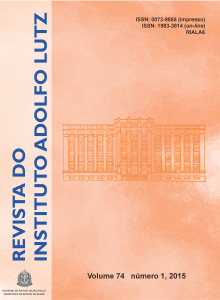Abstract
Bloodstream infections due to Candida genus are one of the leading cause of morbidity and mortality in immunocompromised patients. Candida albicans remains to be the yeast species which is the most commonly isolated in these infections. This species is easily and rapidly identified. However there are other species such as Candida parapsilosis, C. tropicalis, C. glabrata and C. krusei, which are of lower frequency and they take longer to be detected; and commercially available automated or semi-automated methodologies are needed for their identification. Hundred forty-six yeast strains were analyzed for evaluating the capability of the API 20C AUX® system (Biomerieux®, France) for correctly identifying the microorganism genus and specie in different reading periods of time, and to release the final results in less time. C. parapsilosis, C. guilliermondii, Candida pelliculosa, C. colliculosa, Rhodotorula mucilaginosa, Saccharomyces cerevisae, Trichosporon mucoides and T. asahii were the yeasts released in times of 96, 120 and 144 h. Eighty percent of C. glabrata and 69 % of C. tropicalis were also identified in periods beyond the established time. With the achieved results, it is feasible to anticipate the identification of the gender and of some yeast species.References
1. Arendrup MC, Fuursted K, Gahrn-Hansen B, Jensen IM, Knudsen JD, Lundgren B, et al. Seminational surveillance of fungemia in Denmark 2004-2006: increasing incidence of fungemia and numbers of isolates with reduced azole susceptibility. J Clin Microbiol. 2005;43(9):4434-40. doi: 10.1128/JCM.43.9.4434-4440.2005.
2. Espinel-Ingroff A, Canton E, Peman J, Rinaldi MG, Fothergill AW. Comparison of 24-hour and 48-hour voriconazole MICs as determined by the Clinical and Laboratory Standards Institute broth microdilution method (M27–A3 document) in three laboratories: results obtained with 2,162 clinical isolates of Candida spp. and other yeasts. J Clin Microbiol. 2009;47:2766–71. doi: 10.1128/JCM.00654-09.
3. Pappas PG, Kauffman CA, Andes D, Benjamin DK Jr, Calandra TF, Edwards JE, et al. Clinical practice guidelines for the management of candidiasis: 2009 update by the Infectious Diseases Society of America. Clin Infect Dis. 2009;48:503-35. doi: 10.1086/596757
4. Pfaller MA, Pappas PG, Wingard JR. Invasive fungal pathogens: current epidemiological trends. Clin Infect Dis. 2006;43:S3-S14.
5. Colombo AL, Nucci M, Park BJ, Nouér SA, Arthington-Skaggs B, da Matta DA, et al. Epidemiology of candidemia in Brazil: a nationwide sentinel surveillance of candidemia in eleven medical centers. J Clin Microbiol. 2006;44(8):2816-23. doi: 10.1128/JCM.00773-06.
6. da Matta DA, De Almeida LP, Machado AM, Azevedo AC, Kusano EJ, Travassos NF, et al. Antifungal susceptibility of 1000 Candida bloodstream isolates to 5 antifungal drugs: results of a multicenter study conducted in São Paulo, Brazil, 1995–2003. Diagn Microbiol Infect Dis. 2007; 57(4): 399-404. doi:10.1016/j.diagmicrobio.2006.10.011.
7. Lacaz CS, Porto E, Martins JEC. Micologia Médica 8ª Ed. Editora Sarvier, São Paulo; 1991.
8. Lopes J, Dalle F, Mantelin P, Moiroux P, Nierlich AC, Pacot A, et al. A. Rapid identification of Candida glabrata based on trealose and sucrose assimilation using Rosco Diagnostic Tablets. J Clin Microbiol. 2001;39(3):1172-4. doi: 10.1128/JCM.39.3.1172-1174.2001.
9. Ruiz LS, Paula CR. Fungemia por leveduras: perfis fenotípicos e moleculares e sensibilidade antifúngicas de amostras isoladas no Hospital das clinicas de Botucatu, São Paulo [tese de doutorado]. São Paulo (SP): Universidade de São Paulo, 2008.
10. Odds FC, Bernaerts R. CHROMagar Candida, a new differential isolation medium for presumptive identification of clinically important Candida species. J Clin Microbiol. 1994;32(8):1923–9.
11. Cooke V, Miles RJ, Price RG, Midgley G, Khamri W, Richardson AC. New chromogenic agar medium for the identification of Candida spp. Appl Environ Microbiol. 2002;68(7):3622–7. doi: 10.1128/AEM.68.7.3622-3627.2002.
12. Khan ZU, Suhail A, Mokaddas E, Chandy R. Tobacco agar, a new method for differentiating Candida dubliniensis from Candida albicans. J Clin Microbiol. 2004;42(10):4796-8. doi: 10.1128/JCM.42.10.4796-4798.2004.
13. Baixench MT, Taillandier A, Paugam A. Clinical and experimental evaluation of a new chromogenic medium (OCCA, Oxoid) for direct identification of Candida albicans, C. tropicalis and C. krusei. Mycoses. 2006;49(4):311-5. doi: 10.1111/j.1439-0507.2006.01259.x.
14. Wadlin JK, Hanko G, Stewart R, Pape J, Nachamkin I. Comparison of three commercial systems for identification of yeasts commonly isolated in the clinical microbiology laboratory. J Clin Microbiol. 1999;37(6): 1967-70.
15. Silva JO, Candido RC. Evaluation of the API20C AUX system for the identification of clinically important yeasts. Rev Soc Bras Med Trop. 2005;38(3):261–3. http://dx.doi.org/10.1590/S0037-86822005000300012.

This work is licensed under a Creative Commons Attribution 4.0 International License.
Copyright (c) 2015 Instituto Adolfo Lutz Journal
